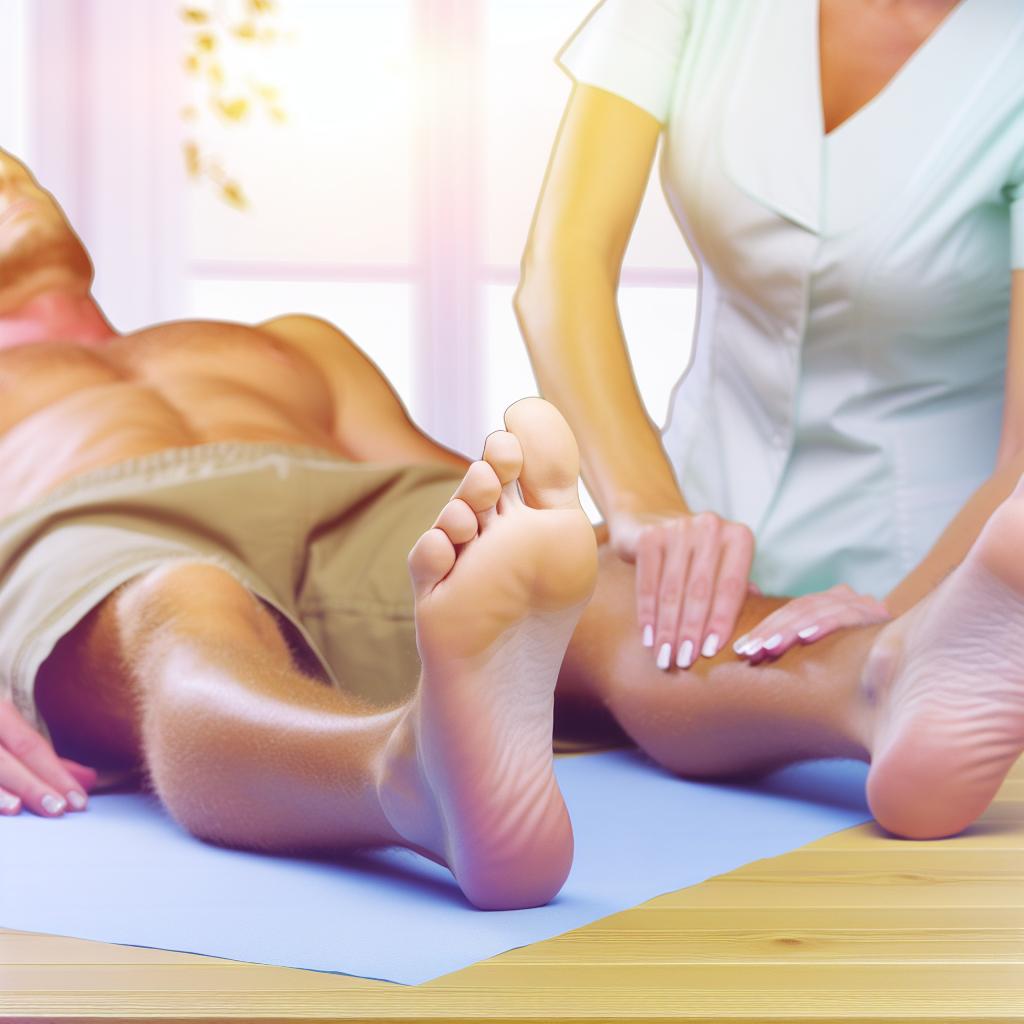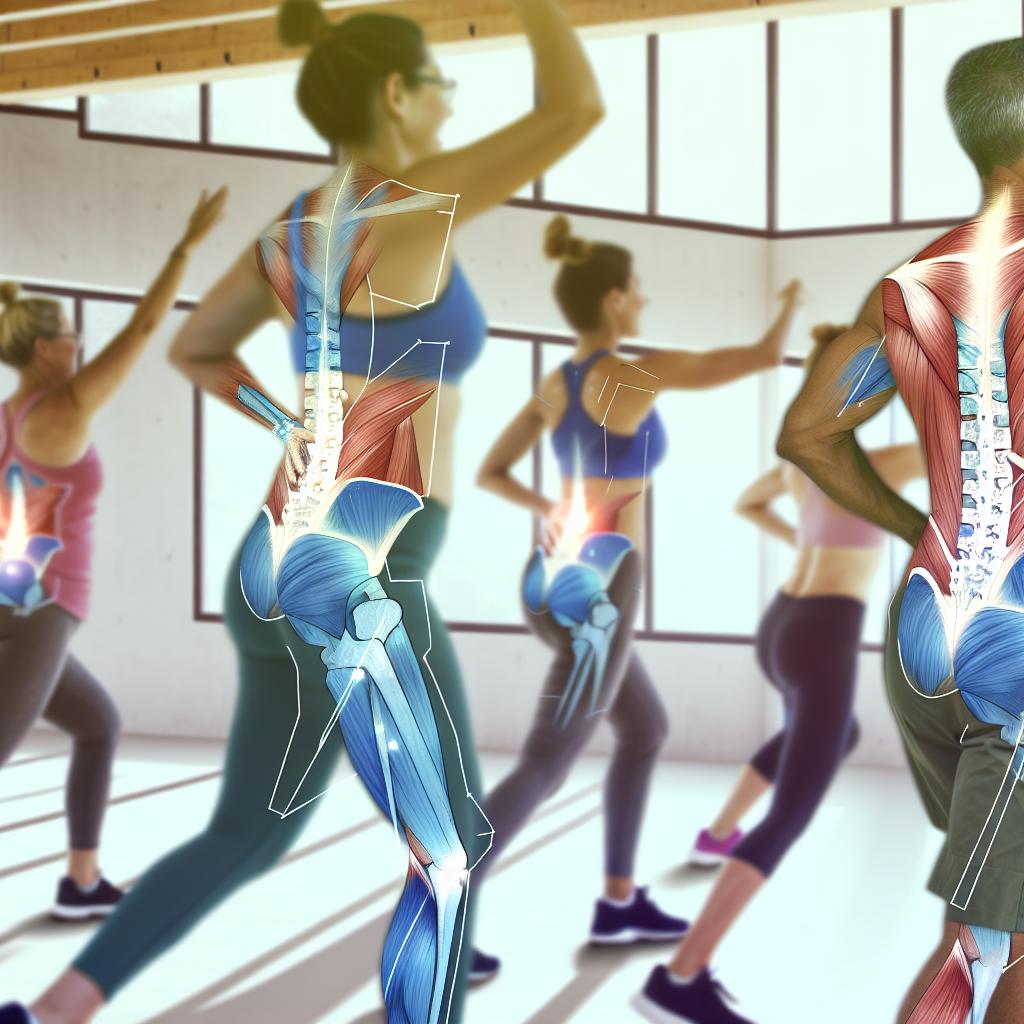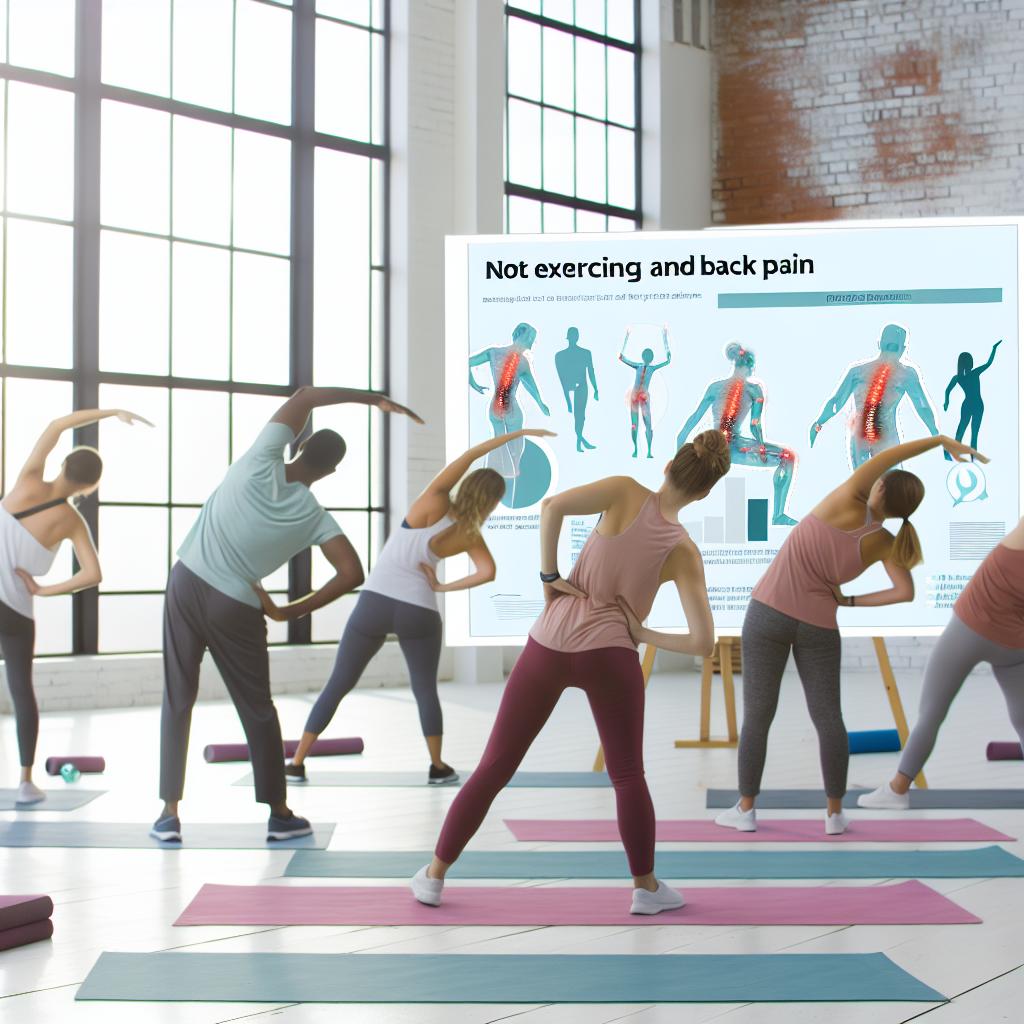In today’s sedentary lifestyle, many people overlook the vital connection between physical activity and spinal health. Insufficient exercise can lead to muscle imbalances and increased back pain,as inactivity weakens the core and supports poor posture. Understanding this relationship is crucial for preventing discomfort and maintaining overall wellness.
## understanding the Connection: Can Not Exercising Cause Back Pain? The Link Explained
Consequences of Inactivity on Back Health
Not exercising regularly can contribute considerably to the development of back pain. When the body lacks movement, muscles weaken, and flexibility decreases, leading to poor posture and an increased risk of injury. Here are some key points to understand the connection:
- Muscle weakness: Sedentary lifestyles lead to weakened core muscles, which are crucial for supporting the spine.
- Poor Posture: Inactivity can exacerbate postural issues,causing undue stress on the back.
- Reduced Flexibility: Lack of stretching and mobility exercises can result in stiff muscles and joints.
How Exercise Alleviates Back Pain
Incorporating regular physical activity can definitely help to alleviate and prevent back pain. Exercise promotes blood flow, strengthens muscles, and improves flexibility, which are all vital for maintaining a healthy back. Below are exercises that are notably beneficial:
Recommended Exercises
- Stretching: Simple stretches such as the cat-cow stretch and child’s pose can release tension in the back.
- strength Training: Incorporate gentle strength training targeting the core, such as planks and bridges to build support around the spine.
- Low-Impact Aerobic Activities: Activities like walking or swimming improve overall fitness without putting excessive strain on the back.
Incorporating movement into Daily Life
Making small changes to your daily routine can significantly impact your back health. Here are some actionable tips to get started:
- Set Reminders: Schedule regular breaks to stand up and stretch during prolonged periods of sitting.
- Engage in Daily Activities: Opt for climbing stairs rather of using elevators or engage in light housework.
- practice Good Posture: Ensure your workspace is ergonomically designed to support back health.
## The Role of Muscle Strength and Flexibility in Back Health: Can Not Exercising cause Back pain? The Link Explained
The Importance of Muscle Strength
Muscle strength plays a crucial role in maintaining back health. Weak core muscles can lead to an increased risk of lower back pain as they fail to provide adequate support for the spine. Strengthening exercises that target the core, such as planks and bridges, can significantly enhance the stability of your back. Here are some key benefits of strong core muscles:
- improved posture
- Reduced strain on the lower back
- Enhanced physical performance in daily activities
The Role of Flexibility
Flexibility is equally essential in preventing back pain. A body with limited flexibility is more prone to muscle strain and discomfort. Regular stretching can help keep muscles limber, thereby supporting the back. Implement these flexibility exercises to enhance your range of motion:
Effective Stretching Exercises
- Cobra Stretch: Lie on your stomach, place your palms on the floor beneath your shoulders, and gently push your upper body up. Hold for 15-30 seconds.
- Child’s Pose: Kneel on the floor, sit back on your heels, and stretch your arms forward on the ground. Hold for 30 seconds.
- Hamstring Stretch: Sit with one leg extended and the other leg bent, reach for your toes on the extended leg and hold for 15-30 seconds.
Can Inactivity Lead to Back Pain?
Yes, not exercising can contribute to back pain. Sedentary lifestyles result in weakened muscles and decreased flexibility, putting individuals at risk for various musculoskeletal issues. Incorporating regular strength and flexibility training into your routine can definitely help mitigate these risks.
## Common Causes of Back Pain related to Sedentary Lifestyles: Can Not Exercising Cause Back Pain? The Link Explained
Understanding the Impact of Sedentary Lifestyles on Back Pain
Leading a sedentary lifestyle can significantly contribute to low back pain (LBP). When the body is inactive for prolonged periods, muscle strength and flexibility decline, creating an imbalance that stresses the spine. This lack of movement can lead to weakened core muscles, essential for supporting the back, and may result in poor posture, further aggravating back pain issues.
Key factors Contributing to Back Pain
- Muscle Weakness: Inactivity leads to weakened muscles, particularly in the abdomen and back, making the spine more susceptible to strain.
- Poor Posture: Sitting for long hours without proper support can cause slouching, which misaligns the spine and increases pressure on spinal structures.
- Decreased flexibility: Lack of movement can result in stiff muscles and joints, which can impair mobility and contribute to discomfort.
Effective Strategies to Combat Back Pain
Incorporating regular physical activity is vital for preventing and alleviating back pain. Here are some simple strategies you can implement:
Recommended Exercises and Stretches
- Walking: Aim for 30 minutes of brisk walking daily to strengthen muscles and improve flexibility.
- Core Strengthening: Engage in exercises like planks and bridges to enhance core stability.
- Stretching: Incorporate stretches, such as the cat-cow stretch or child’s pose, into your routine to maintain flexibility.
Remember to listen to your body and gradually increase activity levels. It’s essential to maintain a balance between exercise and rest to support overall spine health. Implementing these practices can help alleviate low back pain associated with sedentary behavior and improve your overall well-being.
## Effective Exercises to Combat Back Pain: Can Not Exercising Cause Back Pain? The Link Explained
The Impact of Inactivity on Back Pain
not exercising can significantly contribute to the development of back pain. When you remain inactive, your back muscles may weaken, leading to increased stiffness and decreased flexibility.This lack of strength and mobility can create a vicious cycle where discomfort prevents movement, further exacerbating the pain.
How Inactivity Leads to Pain
- Muscle Weakness: Weak muscles provide less support to the spine, resulting in strain.
- Stiffness: Lack of movement can cause muscles and joints to stiffen.
- Poor Posture: Inactivity often leads to poor posture, further aggravating back conditions.
Effective Exercises to Combat Back Pain
Engaging in regular physical activity, including stretching and strengthening exercises, is key to preventing and alleviating back pain. The right exercises can enhance circulation, decrease stiffness, and strengthen the muscles around the spine.
Recommended Exercises
- Cat-Cow Stretch: A gentle stretch to improve flexibility.
- Bridges: Strengthens the lower back and stabilizes the core.
- Pelvic Tilts: Helps to strengthen abdominal muscles.
Step-by-Step Instructions for Each Exercise
| Exercise | Instructions |
|---|---|
| Cat-Cow Stretch |
|
| Bridges |
|
| Pelvic Tilts |
|
Incorporating these exercises into your routine can not only help reduce existing back pain but also prevent future incidents. Remember, the key is consistency and gradually increasing your activity level.
## Practical Solutions and Remedies for Back Pain: Can not Exercising Cause Back Pain? The Link Explained
Understanding the Link Between Inactivity and Back Pain
Not exercising can significantly contribute to back pain due to weakened muscles and reduced flexibility. When your muscles are weak, they cannot adequately support your spine, leading to increased pressure and discomfort. Additionally, inactivity may result in stiffness in the back and surrounding muscles, exacerbating pain.Regular movement is essential for maintaining a healthy back, as it promotes blood flow and nutrient delivery, essential for muscle health.
Why Does Inactivity lead to Back Pain?
- Muscle Weakness: Lack of strength in abdominal and back muscles fails to support the spine properly.
- Reduced Flexibility: Inactive individuals frequently enough experience tighter muscles, limiting their range of motion and comfort.
- Postural Issues: Sedentary lifestyles can lead to poor posture, further straining the back.
actionable Steps to Combat Back Pain
Incorporating low-impact exercises can greatly alleviate back pain and prevent its recurrence. Here’s a simple routine:
- Gentle Stretches:
- Forward bends to enhance hamstring flexibility.
- Child’s pose to stretch the back and relieve tension.
- Strengthening Exercises:
- Pelvic tilts to strengthen lower back muscles.
- Bridges to engage the glutes and stabilizing muscles.
- Planks for core stability.
- Daily Activity: Aim for at least 15 minutes of light physical activity daily, such as walking or cycling, to keep your back muscles engaged.
By integrating these exercises into your daily routine, you can not only manage existing back pain but also significantly reduce the risk of future episodes.
## Overcoming Challenges: Staying Active to Prevent Back pain: Can Not Exercising Cause Back Pain? The Link Explained
The Connection Between Lack of Exercise and Back Pain
Not exercising can significantly increase the risk of developing back pain. When we lead sedentary lifestyles, muscles weaken, particularly those that support our spine. Weak back and core muscles can lead to poor posture and increase the likelihood of injuries. Regular physical activity helps strengthen these muscles, providing better support for the spine, which is crucial for maintaining proper alignment and preventing pain.
Benefits of Staying Active
- Strengthening Core Muscles: engaging in exercises like planks and bridges supports lumbar stability.
- Improving Flexibility: Regular stretching can enhance flexibility in the back and reduce stiffness.
- Promoting Healthy Weight: A consistent workout regimen helps maintain a healthy weight,reducing strain on the back.
Actionable Steps to Prevent Back Pain
To combat the risks associated with inactivity, consider incorporating the following exercises into your routine:
Simple Stretching Exercises
- Cobra Stretch: Lie face down, place your hands under your shoulders, and gently push your upper body up while keeping your hips on the floor.
- Child’s Pose: Kneel on the floor, sit back on your heels, and stretch forward, reaching your arms out on the ground.
- Knees to Chest: Lie on your back and pull your knees toward your chest to stretch the lower back.
strengthening Exercises
- Bird Dog: On hands and knees, extend one arm forward and the opposite leg back, keeping your spine neutral.
- Wall Sits: With your back against the wall, slide down until your thighs are parallel to the floor, holding for 20-30 seconds.
Incorporating these activities into your weekly routine can help you stay active and ward off back pain caused by inactivity. Aim for at least 30 minutes of moderate exercise most days to promote overall spinal health and well-being.
## Incorporating Movement into Your Daily routine: Can Not Exercising Cause Back Pain? The Link Explained
The Importance of Movement
Incorporating movement into your daily routine is essential for maintaining a healthy back. **Not exercising** can weaken your muscles,leading to poor posture and increased back pain. Here are key reasons why staying active is crucial:
- Strengthens Muscles: Regular movement strengthens core muscles, providing better support for the spine.
- Improves Flexibility: Engaging in physical activities enhances flexibility, reducing stiffness and discomfort.
- Boosts Blood Circulation: Enhanced circulation delivers oxygen and nutrients to the back, promoting healing and reducing pain.
Common Effects of a Sedentary Lifestyle
when you opt for a sedentary lifestyle, several issues may arise, contributing to back pain:
- Muscle Atrophy: Lack of use leads to weakened muscles.
- Poor Posture: Spending excessive time sitting can lead to slouched positions.
- Reduced Mobility: Stiff muscles from inactivity can restrict movement.
Simple Strategies to Incorporate Movement
To minimize back pain and contribute to overall health, consider implementing these simple strategies into your day:
- Set Reminders: Use a timer to remind you to stand or stretch every hour.
- Take Short walks: Aim for a swift 5-10 minute walk after every meal.
- Desk Stretches: Perform simple stretches at your desk, such as neck rolls and shoulder shrugs.
Effective Stretches to Relieve Back Tension
| Stretch | Description | Duration |
|---|---|---|
| Child’s Pose | Start on knees, sit back on heels, stretch arms forward on the floor. | Hold for 30 seconds |
| Cobra Stretch | Lie on your stomach, place hands under shoulders, and lift your chest. | Hold for 15-30 seconds |
| Seated Forward Bend | Sit with legs straight, reach toward your toes while keeping your back flat. | Hold for 30 seconds |
Consistent application of these movements and stretches can significantly reduce the risk of back pain associated with inactivity. Remember, small changes can lead to meaningful improvements in your health and well-being.
## Stretching Techniques for Back Relief: Can Not Exercising Cause Back Pain? The Link Explained
Understanding the link Between Inactivity and Back pain
Not exercising can significantly contribute to back pain.**A sedentary lifestyle leads to weakened muscles**, particularly in the core and back, which are crucial for maintaining proper posture and spinal alignment. When these muscles are weak, they are less capable of supporting the spine, increasing the likelihood of discomfort and injury.
How Lack of Exercise Affects Back Health
- Muscle Atrophy: Prolonged inactivity causes muscles to shrink and lose strength.
- Poor Posture: Weak back and core muscles fail to support the spine,leading to slouching.
- reduced Flexibility: Inactivity decreases the flexibility of muscles and tendons, which contributes to stiffness.
effective Stretching Techniques for Back relief
Incorporating stretching into your routine can help alleviate back pain caused by inactivity. Here are some effective stretches you can do:
1. Cat-Cow Stretch
This stretch gently warms up the spine and relieves tension.
- Start on your hands and knees, with wrists under shoulders and knees under hips.
- Inhale, arch your back (cow position), and look up.
- Exhale, round your spine (cat position) and tuck your chin.
- Repeat for 5-10 breaths.
2.Child’s Pose
A restorative stretch that helps relieve tension in the back.
- Kneel on the floor, then sit back on your heels.
- Extend your arms forward and lower your torso to the floor.
- Hold for 30 seconds to 1 minute.
3. Seated Forward Bend
this stretches the spine and hamstrings,promoting flexibility.
- Sit with your legs extended in front of you.
- Inhale, reach your arms overhead, and exhale as you bend forward.
- Hold for 20-30 seconds,breathing deeply.
**Consistency is key** in alleviating back pain and improving overall mobility. Incorporate these stretches into your daily routine to experience significant relief and better spinal health.
## Mindset and Motivation: Staying engaged with Physical Activity to Alleviate Back Pain: Can not Exercising Cause Back Pain? the Link Explained
The Importance of Activity for Back Health
Physical inactivity can significantly contribute to the development of back pain. When we don’t engage in regular exercise, our muscles can weaken, leading to poor posture and reduced flexibility. This lack of strength and suppleness can result in increased strain on the spine, potentially causing discomfort or injury.
Understanding the Link Between Inactivity and Pain
Here are several key reasons why not exercising may lead to back pain:
- Muscle Weakness: Weak core and back muscles can’t support the spine effectively.
- Poor Posture: Prolonged sitting and inactivity can lead to misalignment and muscle imbalances.
- Reduced Flexibility: Lack of stretching can cause tight muscles, which may contribute to pain.
Ways to Stay Engaged with Physical activity
maintaining a consistent exercise routine is crucial for alleviating and preventing back pain.Here are actionable steps to incorporate movement throughout your day:
Simple Daily Activities
- Take regular breaks to stand, stretch, or walk if you have a sedentary job.
- Incorporate walking into your daily routine, aiming for at least 30 minutes.
- Use stairs instead of elevators whenever possible.
Effective Stretches and Exercises
Incorporate these simple exercises into your day to strengthen your back and improve posture:
| Exercise | Description | repetitions |
|---|---|---|
| Cat-Cow Stretch | Alternately arch and round your back while on all fours. | 10 times |
| Bridge Pose | Lying on your back, elevate your hips while squeezing your glutes. | 10 times |
| Child’s Pose | Sit back on your heels and stretch your arms forward while lowering your torso. | Hold for 30 seconds |
By embracing a mindset of motivation and commitment to physical activity, you can significantly reduce the risk of developing back pain. Remember, every little effort counts, and staying active is a key step toward ensuring long-term back health.

Q&A
### can not exercising lead to back pain?
Yes, not exercising can contribute significantly to back pain. When muscles, especially those in the back, abdomen, and core, are weak, they become less effective in supporting the spine. A lack of physical activity can lead to muscle atrophy, where muscles shrink and lose strength, making them more susceptible to injuries and strains. Inactive individuals frequently enough experience increased stiffness in their joints and reduced flexibility, which can exacerbate pain in the lower back.
Additionally, prolonged periods of inactivity can lead to poor posture, especially if one spends long hours sitting. Poor posture can strain the spine and the surrounding muscles,further increasing the risk of back pain. Engaging in regular physical activity strengthens the muscles that support your back and improves flexibility,helping to alleviate or prevent pain.### What types of exercises can definitely help prevent back pain?
To prevent back pain, it is indeed essential to incorporate a mix of strength training, flexibility exercises, and aerobic activity into your routine.
– **Strength training**: Focus on exercises that target the core muscles, including the abdominals, obliques, and lower back. Examples include planks, bridges, and bird-dogs.
- **Flexibility exercises**: Stretching can improve flexibility and reduce muscle tension.Incorporate stretches for the hamstrings, hip flexors, and back muscles. Yoga and Pilates are excellent for enhancing flexibility and core strength.
– **Aerobic activity**: Engaging in activities like walking, swimming, or cycling enhances overall cardiovascular health and helps maintain a healthy weight, both of which can reduce the strain on your back.### How can poor posture contribute to back pain?
Poor posture can have a detrimental impact on the spine and the surrounding muscles, leading to back pain. When you slouch or sit improperly, the spine can become misaligned. Over time, this misalignment places undue stress on the vertebrae and soft tissues, causing pain.
– **Common postural issues**: Slouching in a chair, craning your neck while looking at screens, or standing with your hips thrusting forward can all contribute to muscle imbalances and strain on the back.
To combat this, practice maintaining a neutral spine in all your positions—sitting, standing, or moving. Regular breaks from prolonged sitting and consciously adjusting your posture can alleviate stress on your back.### Is sitting for long periods linked to back pain?
Yes, sitting for extended periods has been directly linked to back pain. Sedentary behavior leads to weakened core and back muscles, which are crucial for stabilizing the spine. A study showed that individuals who sit for prolonged periods without movement are at a higher risk for experiencing low back pain [[1](https://www.physio-pedia.com/Inactivity_and_Low_Back_Pain)].
To mitigate the effects of prolonged sitting, aim to:
– **Take regular breaks**: Stand or walk for a few minutes every hour to promote blood flow and keep muscles active.
– **Use ergonomic furniture**: Invest in a supportive chair and ensure your workspace is set up to promote good posture.
### Can stretching alleviate back pain?
yes, stretching can be an effective way to alleviate back pain. It helps improve flexibility, reduce muscle tension, and increase blood flow to the muscles and soft tissues around the spine.Regular stretching can prevent stiffness and maintain range of motion, which is crucial for protecting the back from injuries.
- **Effective stretches**: Incorporate hamstring stretches, lower back twists, and hip flexor stretches into your routine. These can help release tension in the muscles that often contribute to back pain.
Its beneficial to perform stretching exercises daily or after prolonged periods of sitting. Remember to listen to your body and avoid forcing any movements that cause pain.
### What role does weight management play in back pain prevention?
Maintaining a healthy weight is essential for preventing back pain.Excess weight can strain the muscles, ligaments, and discs in your spine, leading to discomfort and pain. A study indicated that individuals with higher body mass index (BMI) were more likely to experience persistent low back pain [[2](https://odphp.health.gov/myhealthfinder/healthy-living/safety/prevent-back-pain)].
to manage your weight effectively, consider the following strategies:
– **Balanced diet**: Focus on whole, nutrient-dense foods, such as fruits, vegetables, lean proteins, and whole grains.
– **Regular exercise**: Incorporate both strength training and aerobic activities to promote weight loss and strengthen core muscles.
by staying active and keeping your weight within a healthy range, you can significantly reduce the risks associated with back pain.
Key Takeaways
## Conclusion: understanding the Link Between Inactivity and Back Pain
the connection between **not exercising** and experiencing back pain is significant and worth addressing. Here’s a recap of key points and actionable steps you can take to improve your back health:
### Key Takeaways
– **inactivity Increases Risk**: A sedentary lifestyle can weaken your back muscles and increase the likelihood of pain.
– **Strengthening Matters**: Incorporating targeted exercises can enhance muscle strength and flexibility, thereby supporting your spine.
– **Posture Awareness**: Improving your posture during daily activities can reduce strain on your back.
### Action steps for a Healthier Back
1. **Start Slowly**: If you’re new to exercise, begin with gentle activities such as walking, stretching, or yoga.
2. **Incorporate Strength Training**: Aim for two to three sessions a week, focusing on core and back muscle workouts.
3. **Practice Posture**: Maintain good posture when sitting, standing, or lifting to prevent needless strain.
4. **Stay Informed**: Educate yourself about back health through reliable resources and consider consulting healthcare professionals for personalized advice.### Your Journey to a Pain-Free Back
Remember, the journey towards a pain-free back starts with small, manageable steps. By prioritizing movement and incorporating exercises tailored to your back’s needs, you can effectively manage and reduce pain over time.
Stay committed to taking care of your body, and don’t hesitate to seek support or guidance as you embark on this path. Here’s to a healthier, more active lifestyle that supports your spine!
—
Feel free to integrate these insights and actions into your daily routine and watch your back health transform positively.











